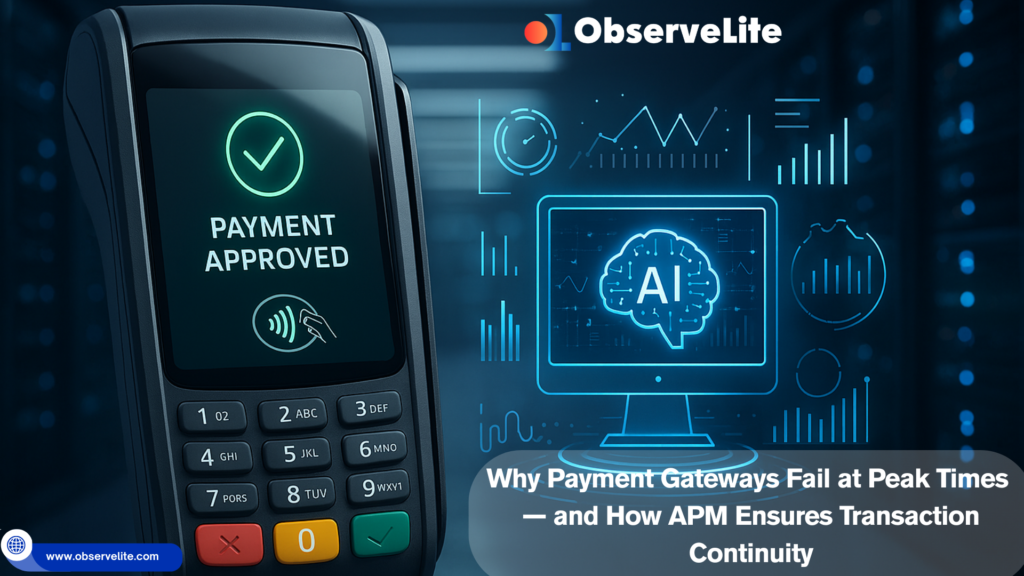Every e-commerce business, subscription platform, or digital service provider knows the nightmare of payment gateway downtime. It usually strikes at the worst possible moment — during a flash sale, peak holiday shopping, or high-volume billing cycles. Transactions fail, carts are abandoned, and frustrated customers leave for competitors.
This is where ObserveLite APM makes a difference. By combining predictive monitoring, anomaly detection, and automated insights, it empowers businesses to stay ahead of performance failures and guarantee smooth, reliable transactions.
What Causes Payment Gateway Downtime?
Payment gateway downtime is rarely caused by one issue — it’s usually a mix of technical, operational, and external factors. Common triggers include:
- High transaction spikes during holidays or sales events.
- Server overloads or poor load balancing.
- Third-party API dependencies like fraud detection tools or banking integrations.
- Network disruptions across data centers or ISPs.
- Configuration errors or code updates that go unnoticed.
Without proactive monitoring, businesses often only discover these issues when customers begin reporting failed payments — by then, the damage is already done.
How to Detect Payment Gateway Outages in Real-Time
Manual monitoring is no longer enough. Detecting outages in real-time requires:
- Synthetic monitoring that simulates transactions across geographies.
- Real-user monitoring (RUM) to capture live customer experiences.
- AI-powered anomaly detection to flag unusual latency or error rates.
ObserveLite APM combines these approaches to alert teams at the first sign of transaction degradation — ensuring IT teams can act before failures cascade.
How Can Businesses Mitigate Losses from Payment Gateway Downtime?
The financial and reputational cost of downtime is massive. A single hour of payment outages can cost millions for global retailers. To reduce losses, businesses should:
- Implement failover gateways for automatic transaction rerouting.
- Use predictive monitoring to forecast when traffic surges may trigger instability.
- Prioritize critical transactions (e.g., recurring subscriptions, high-value payments).
- Establish incident playbooks to cut response times.
With APM-driven foresight, businesses move from reacting to outages to preventing them.
Are There Tools to Monitor Payment Gateway Performance?
Yes — and this is where ObserveLite APM provides a clear edge. While traditional monitoring tools might simply show whether a system is “up” or “down,” ObserveLite focuses on deeper insights that matter for financial transactions:
- Full transaction visibility – Every payment request is tracked from the customer’s device through APIs, databases, and backend services, giving banks and merchants a clear picture of where slowdowns occur.
- Proactive intelligence – Instead of waiting for errors to surface, advanced models anticipate unusual patterns that could point to congestion, fraud, or infrastructure strain.
- Regulation-ready reporting – Dashboards are built with financial compliance in mind, making audits and regulatory checks smoother.
- Automated resilience – If systems face stress, traffic can be rerouted or additional resources activated without waiting for manual intervention.
With this approach, businesses don’t just see that a gateway failed — they know why it happened and how to fix it quickly, before customers feel the impact.
Can Businesses Use Multiple Payment Gateways for Redundancy?
Absolutely. Redundancy is one of the strongest safeguards against downtime. Many organizations adopt a multi-gateway strategy to:
- Spread transaction volume across providers.
- Switch automatically when one provider slows down.
- Optimize for geographic regions or currencies.
ObserveLite APM complements this by monitoring all gateways simultaneously, ensuring seamless continuity across backup systems.
What Is the Cost of Downtime for E-Commerce Sites?
The cost depends on scale, but it’s always high:
- Lost sales revenue during outages.
- Increased cart abandonment rates.
- Customer churn when users lose trust.
- Reputational damage amplified by social media.
Industry studies estimate that downtime can cost $5,600 per minute on average. For e-commerce giants, that figure can be exponentially higher.
Are There Tools to Monitor Third-Party Service Issues?
Yes — but businesses often underestimate how much downtime originates from third-party APIs like fraud checks, banking networks, or currency converters.
ObserveLite APM provides dependency monitoring, showing how external services impact overall payment performance. This level of transparency ensures businesses aren’t blindsided by failures outside their direct control.
What Is a Failover Strategy for Payment Processing?
A failover strategy ensures business continuity even when the primary gateway fails. Key elements include:
- Backup gateways configured for automatic rerouting.
- Load balancers that distribute traffic evenly.
- Continuous monitoring to detect when failover should trigger.
With ObserveLite APM, businesses gain visibility into whether failovers actually work as intended, reducing the risk of “silent failures.”
FAQs
Q1. What are the most common signs of upcoming payment gateway downtime?
Slow transaction approvals, increasing API errors, and higher-than-usual latency are red flags.
Q2. Do businesses get notified when payment gateways are down?
Yes, but often too late. APM ensures you’re alerted before customers are affected.
Q3. How do payment gateway outages affect customer trust?
Even one failed transaction can cause customers to switch providers. Consistent reliability is critical.
Q4. Can APM help with regulatory compliance during outages?
Yes. Tools like ObserveLite APM provide audit trails and SLA reporting for financial governance.
Q5. Which payment gateways have the best uptime?
Uptime varies, but redundancy plus proactive monitoring is the safest approach.
Conclusion
Payment gateway downtime is not just an IT inconvenience — it’s a direct threat to revenue, compliance, and customer loyalty. Businesses that rely solely on reactive monitoring remain vulnerable to costly disruptions.
With ObserveLite APM, companies gain the predictive insights and real-time visibility needed to keep transactions running smoothly, even during peak demand. By ensuring continuity, resilience, and trust, ObserveLite helps businesses turn payment reliability into a lasting competitive advantage.


